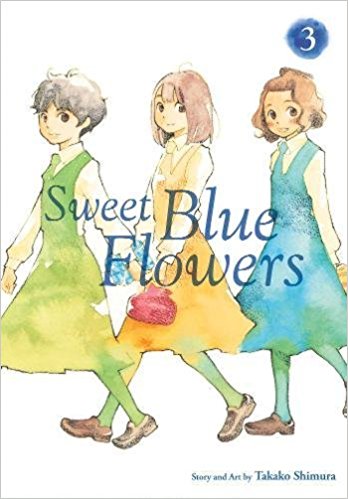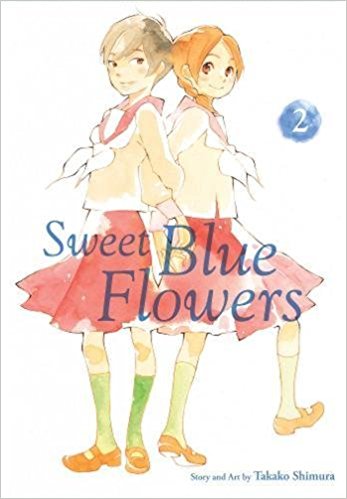By Takako Shimura. Released in Japan as “Aoi Hana” by Ohta Shuppan, serialized in the magazine Manga Erotics F. Released in North America by Viz. Translated by John Werry.
The final volume of Sweet Blue Flowers shows off all the strengths and weaknesses of this particular series. Akira and Fumi make very good leads, and there are some deft story touches in this book, particularly in how their breakup is conveyed wordlessly – we’re not actually seeing it straight on, but obliquely. And yes, there’s a breakup, but don’t panic, yuri fans. Just as the reader was meant to be very wary when Akira suggested dating while she sorts out her feelings, so the reader somehow knows that the breakup isn’t going to be permanent. It is interesting, given how negative and toxic the feeling is in so many other manga out there, that it’s Akira feeling jealousy of Fumi possibly seeing other girls that makes her realize “oh, I *do* love her like that.” She also looks so much better with her hair cut it’s not even funny. Their story was the main reason to read the series, and it’s worth the read.
This does leave the rest of the book and the rest of the cast, and I was sort of up and down about that. I still say that, even if the cast list is somewhat helpful, a lot of Shimura’s characters look and act too similarly, especially the giant pile of younger students. More than that, though, at times when the narrative was focused elsewhere I felt like I was drifting through the book like at a party, catching fragments of conversation about events that should be important but don’t have time to grab me before we’ve moved on. Now, to a degree this can be refreshing. It’s clear that every girl in the cast has things going on besides what we see on the page, and I like characters with full, rich lives. But I sometimes wish the manga had more focus – its desire to flit from cast member to cast member made me feel like I was reading though a gauzy haze.
Overall, though, I’m very pleased we finally got to see this series come out in North America. It’s girls in school falling in love, yes, but the diffuseness I mentioned above also helps to separate it from the series that followed in its wake, many of which we saw here first. I also enjoyed the odd serious moments of melancholy, such as the backstory with Kyoko and her mother, which was sad and depressing without making the reader feel angry. And the teacher was a highlight of the entire series, and we saw that her own attempts to come out more publicly had both its ups and downs – I’m not sure if she’s in trouble at school, like so many plotlines in this series it gets carefully examined and then we move on – but it was great to see her imagining a double bride wedding. I do think this series ended at just the right length – it would have been exhausting to carry on for 3-4 more volumes. In the end, Sweet Blue Flowers had its bittersweet moments, but the end showed that sweetness can win out.





